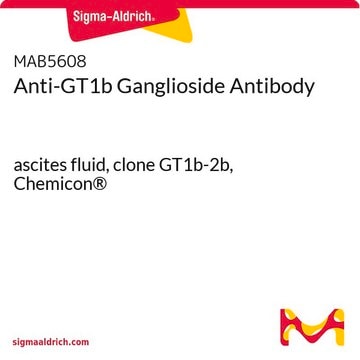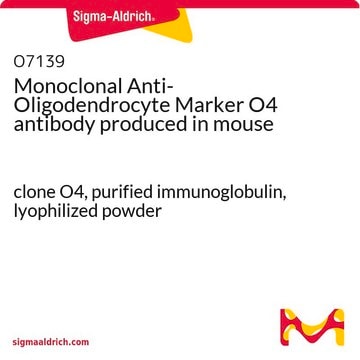MABC1112
Anti-Diasialoganglioside GD3 Antibody, clone R24
clone R24, from mouse
Sinônimo(s):
GD3, Ganglioside GD3, Disialoganglioside GD3
About This Item
Produtos recomendados
fonte biológica
mouse
Nível de qualidade
forma do anticorpo
purified antibody
tipo de produto de anticorpo
primary antibodies
clone
R24, monoclonal
reatividade de espécies
human, mouse, rat
técnica(s)
affinity binding assay: suitable
flow cytometry: suitable
immunohistochemistry (formalin-fixed, paraffin-embedded sections): suitable
immunoprecipitation (IP): suitable
western blot: suitable
Isotipo
IgG3κ
Condições de expedição
ambient
modificação pós-traducional do alvo
unmodified
Informações sobre genes
human ... ST8SIA1(6489)
Categorias relacionadas
Descrição geral
Especificidade
Imunogênio
Aplicação
Affinity Binding Assay: A representative lot reacted with heat stable glycolipid on the surface of all SK-MEL melanoma and two of the five astrocytoma cells tested, whereas epithelial cell types, fibroblasts, and cells of hematopoietic origin were found to lack the surface antigen recognized by clone R24 (Dippold, W.G., et al. (1980). Proc. Natl. Acad. Sci. U.S.A. 77(10):6114-6118).
Flow Cytometry Analysis: A representative lot immunostained the surface of cultured primary rat cerebellar cells (Kasahara, K., et al. (1997). J. Biol. Chem. 272(47):29947-29953).
Immunocytochemistry Analysis: A representative lot immunostained NGF-induced nurite outgrowths of cultured DRG neurons from wild-type, but not GD3 synthase-knockout, mice (Ribeiro-Resende, V.T., et al. (2014). PLoS One. 9(10):e108919).
Immunohistochemistry Analysis: A representative lot detected GD3 immunoreactivity in unfixed frozen tissue samples of primary melanoma and metastatic malignant melanoma (Dippold, W.G., et al. (1985). Cancer Res. 45(8):3699-3705).
Immunoprecipitation Analysis: A representative lot co-immunoprecipitated Lyn from rat brain membrane extract. Clone R24 co-immunoprecipitated caveolin and the exogenously expressed Lyn, but not Src, from CHO cells expressing exogenous GD3 synthase (Kasahara, K., et al. (1997). J. Biol. Chem. 272(47):29947-29953).
Apoptosis & Cancer
Qualidade
Flow Cytometry Analysis: 0.2 µL of this antibody detected GD3 immunoreactivity on the surface of one million SK-MEL-28 human skin melanoma cells.
forma física
Armazenamento e estabilidade
Handling Recommendations: Upon receipt and prior to removing the cap, centrifuge the vial and gently mix the solution. Aliquot into microcentrifuge tubes and store at -20°C. Avoid repeated freeze/thaw cycles, which may damage IgG and affect product performance.
Outras notas
Exoneração de responsabilidade
Não está encontrando o produto certo?
Experimente o nosso Ferramenta de seleção de produtos.
Código de classe de armazenamento
12 - Non Combustible Liquids
Classe de risco de água (WGK)
WGK 2
Ponto de fulgor (°F)
Not applicable
Ponto de fulgor (°C)
Not applicable
Certificados de análise (COA)
Busque Certificados de análise (COA) digitando o Número do Lote do produto. Os números de lote e remessa podem ser encontrados no rótulo de um produto após a palavra “Lot” ou “Batch”.
Já possui este produto?
Encontre a documentação dos produtos que você adquiriu recentemente na biblioteca de documentos.
Active Filters
Nossa equipe de cientistas tem experiência em todas as áreas de pesquisa, incluindo Life Sciences, ciência de materiais, síntese química, cromatografia, química analítica e muitas outras.
Entre em contato com a assistência técnica








